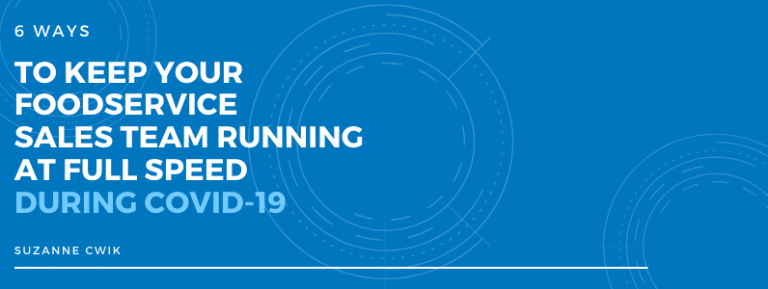[vc_row][vc_column][vc_column_text margin_bottom=”30″ css=”.vc_custom_1584743915476{margin-bottom: 30px !important;}”]With things changing day by day, we are all adjusting to our new normal of remote working, social distancing and restricted travel. However, this doesn’t mean that our sales strategy is on hold, instead we want to help guide you through this challenging time with some simple “plays” you can start implementing in your business today.[/vc_column_text][vc_column_text margin_bottom=”30″ css=”.vc_custom_1602000387727{margin-bottom: 0px !important;}”]
Business closures from the Coronavirus are significantly impacting manufacturer sales, though the impact varies across segments. For instance, QSR’s should see moderate declines, while lodging and B&I will be severely hit. K-12 schools and colleges are closed, but some schools are still feeding children breakfast and lunch via grab-and-go kits. While your sales team can identify which of the largest Operator Ship-To’s remain open, you still need to know what and how much they’re purchasing. Plus, your sales team won’t be able to keep up with the hundreds of smaller accounts. Therefore, you need visibility to sales by segment, down to the Operator Ship-to, for optimal sales execution and forecasting.

Step 1: Validate which Operator Ship-To’s are still purchasing food—and how much, how often.
Step 2: Deploy sales resources to support the appropriate accounts (virtually.)
Step 3: Develop data-driven sales forecasts to help adjust during this volatile time.[/vc_column_text][vc_column_text margin_bottom=”30″ css=”.vc_custom_1602000438965{margin-bottom: 0px !important;}”] The Coronavirus has ushered in a period of extreme uncertainty and volatility. You want to know how many Operator Ship-To’s are still open, so you can deploy sales resources effectively. You need timely data, but most foodservice claims tend to lag 30+ days. A handful of distributors like US Foods, Reinhart, and Shamrock report weekly, so you could use their data as a pulse check. However, that raw data needs to be scrubbed and mastered before it’s actionable.
The Coronavirus has ushered in a period of extreme uncertainty and volatility. You want to know how many Operator Ship-To’s are still open, so you can deploy sales resources effectively. You need timely data, but most foodservice claims tend to lag 30+ days. A handful of distributors like US Foods, Reinhart, and Shamrock report weekly, so you could use their data as a pulse check. However, that raw data needs to be scrubbed and mastered before it’s actionable.

Step 1: Focus on distributors that report weekly to get a sense of the rapidly evolving trends.
Step 2: Deploy sales teams (virtually) to engage key operators: ensure their needs are being met, reassure them of supply chain reliability, and communicate contingency plans.
Step 3: Recommend the most appropriate products to help operations or bolster consumer confidence in food safety.[/vc_column_text][vc_column_text margin_bottom=”30″ css=”.vc_custom_1602000448267{margin-bottom: 0px !important;}”]
To help flatten the curve, many businesses have implemented travel restrictions and work-from-home mandates, and visitor restrictions. However, salespeople can utilize time in the office by analyzing claim data to ensure their operator customers’ needs are being met and even proactively look for opportunities to help with unit operations during these challenging times.

Step 1: Review claims for your distributors that reports weekly.
Step 2: Examine an Operator Ship-To’s pre-Coronavirus purchases, and for those that remain open, evaluate whether different products—like single-serve as replacement for bulk packaging—would benefit unit operations.
Step 3: Salespeople can also prepare for the eventual resumption of operations: develop a purchasing profile for their largest accounts to ensure no items fall off an Operator’s ‘grocery list.'[/vc_column_text][vc_column_text margin_bottom=”30″ css=”.vc_custom_1602000457158{margin-bottom: 0px !important;}”]
It’s unclear how far off we are from resuming normal foodservice industry operations. While many forced closures are tentatively set to expire the beginning of April, that timeframe could easily be extended by weeks or months. But when operations do resume, manufacturers need to be ready to support their operator customers, like verifying items are in stock at a distributor. Sales should also ensure none of their products fall off the Operator Ship-To’s ‘grocery list’ or get replaced by a competitive item. The scramble to resume operations could potentially be a time to optimize assortment and take share from competitors.

Step 1: Create high-value target lists and identify the largest locations in the highest-opportunity segments.
Step 2: Determine whether those products are in stock. [/vc_column_text][vc_column_text margin_bottom=”30″ css=”.vc_custom_1602000466392{margin-bottom: 0px !important;}”]
Some hospitals may see a moderate increase in volume since more employees will be working longer hours and are less likely to go out for meals. Most hospital cafeteria sales are to staff. Since volume has drastically fallen off in other segments like education and business, you’ll want to target these healthcare Operator Ship-To’s—both new customers and existing—with the most appropriate products to help their unit operations and recoup lost sales from other segments.

Step 1: Identify the largest hospitals not purchasing products that are most appropriate for unit operations during this crisis, like grab/heat & go items.
Step 2: Target Operator Ship-To’s purchasing one type of product to swap out for another, like replacing bulk cereal with single-serve.
Step 3: Determine the highest-value location white space target lists.[/vc_column_text][vc_column_text margin_bottom=”30″ css=”.vc_custom_1602000479365{margin-bottom: 0px !important;}”] Most of the foodservice industry is in a tailspin from Coronavirus closures. However, select segments will continue to hold up or even experience increased demand, like hospitals, kit makers, and food banks. Certain products well-suited to this crisis, like single-serve, will likewise perform well. Manufacturers need to drill into those outperformers to create effective sales execution plans and more accurate forecasts.
Most of the foodservice industry is in a tailspin from Coronavirus closures. However, select segments will continue to hold up or even experience increased demand, like hospitals, kit makers, and food banks. Certain products well-suited to this crisis, like single-serve, will likewise perform well. Manufacturers need to drill into those outperformers to create effective sales execution plans and more accurate forecasts.

Step 1: Determine if outperforming products are in stock at your distributors.
Step 2: View weekly distributor purchase trends to anticipate direct sales for those products.
Step 3: Deploy your sales resources (virtually) to support the appropriate accounts.
Step 4: Develop data-driven sales forecasts to help navigate this volatile time. [/vc_column_text][vc_column_text margin_bottom=”30″ css=”.vc_custom_1584744953465{margin-bottom: 0px !important;}”]We know the future is still uncertain, but this doesn’t mean we should wait to see it out; Businesses that act swiftly have a better chance of weathering the storm.[/vc_column_text][/vc_column][/vc_row]






Great read – thx!